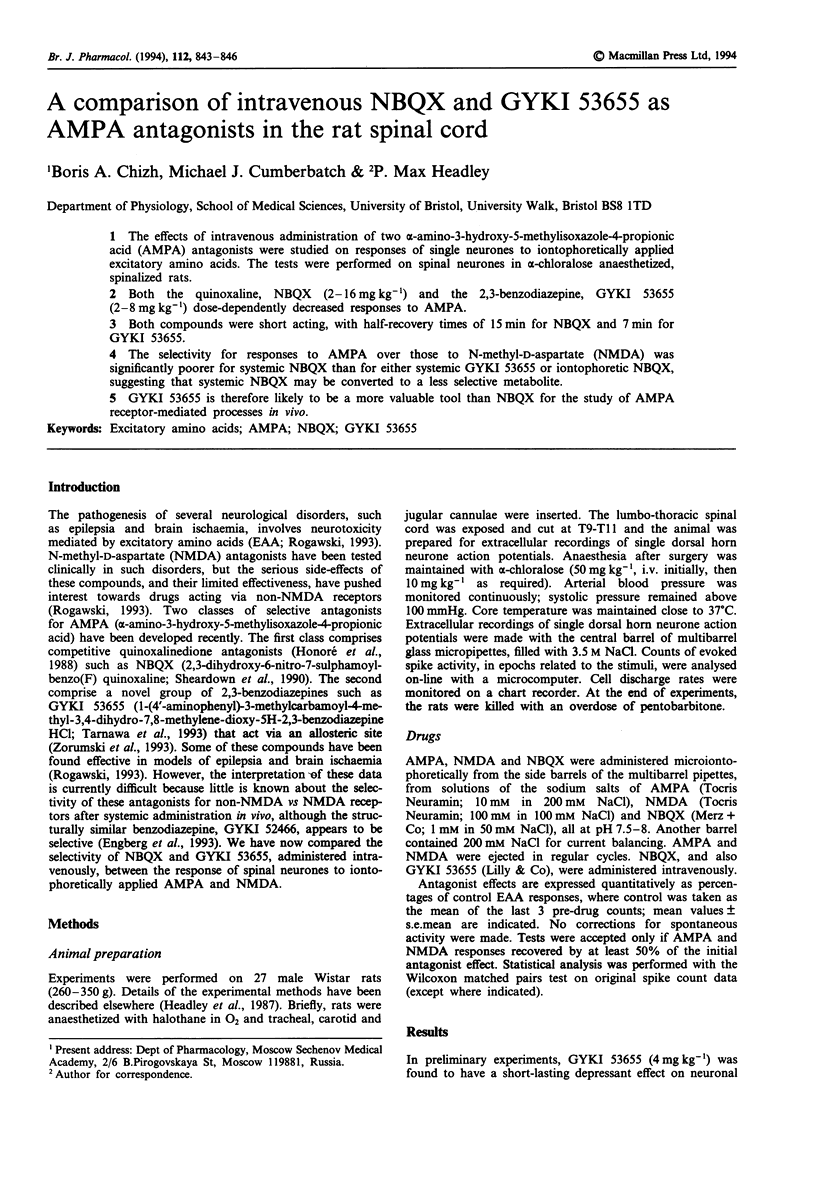Abstract
1. The effects of intravenous administration of two alpha-amino-3-hydroxy-5-methylisoxazole-4-propionic acid (AMPA) antagonists were studied on responses of single neurones to iontophoretically applied excitatory amino acids. The tests were performed on spinal neurones in alpha-chloralose anaesthetized, spinalized rats. 2. Both the quinoxaline, NBQX (2-16 mg kg-1) and the 2,3-benzodiazepine, GYKI 53655 (2-8 mg kg-1) dose-dependently decreased responses to AMPA. 3. Both compounds were short acting, with half-recovery times of 15 min for NBQX and 7 min for GYKI 53655. 4. The selectivity for responses to AMPA over those to N-methyl-D-aspartate (NMDA) was significantly poorer for systemic NBQX than for either systemic GYKI 53655 or iontophoretic NBQX, suggesting that systemic NBQX may be converted to a less selective metabolite. 5. GYKI 53655 is therefore likely to be a more valuable tool than NBQX for the study of AMPA receptor-mediated processes in vivo.
Full text
PDF



Selected References
These references are in PubMed. This may not be the complete list of references from this article.
- Bisaga A., Krzascik P., Jankowska E., Palejko W., Kostowski W., Danysz W. Effect of glutamate receptor antagonists on N-methyl-D-aspartate- and (S)-alpha-amino-3-hydroxy-5-methyl-4-isoxazolepropionic acid-induced convulsant effects in mice and rats. Eur J Pharmacol. 1993 Oct 5;242(3):213–220. doi: 10.1016/0014-2999(93)90244-c. [DOI] [PubMed] [Google Scholar]
- Donevan S. D., Rogawski M. A. GYKI 52466, a 2,3-benzodiazepine, is a highly selective, noncompetitive antagonist of AMPA/kainate receptor responses. Neuron. 1993 Jan;10(1):51–59. doi: 10.1016/0896-6273(93)90241-i. [DOI] [PubMed] [Google Scholar]
- Engberg I., Tarnawa I., Durand J., Ouardouz M. An analysis of synaptic transmission to motoneurones in the cat spinal cord using a new selective receptor blocker. Acta Physiol Scand. 1993 Jun;148(2):97–100. doi: 10.1111/j.1748-1716.1993.tb09537.x. [DOI] [PubMed] [Google Scholar]
- Headley P. M., Parsons C. G., West D. C. The role of N-methylaspartate receptors in mediating responses of rat and cat spinal neurones to defined sensory stimuli. J Physiol. 1987 Apr;385:169–188. doi: 10.1113/jphysiol.1987.sp016490. [DOI] [PMC free article] [PubMed] [Google Scholar]
- Honoré T., Davies S. N., Drejer J., Fletcher E. J., Jacobsen P., Lodge D., Nielsen F. E. Quinoxalinediones: potent competitive non-NMDA glutamate receptor antagonists. Science. 1988 Aug 5;241(4866):701–703. doi: 10.1126/science.2899909. [DOI] [PubMed] [Google Scholar]
- Lodge D., Jones M. G., Palmer A. J. Excitatory amino acids: new tools for old stories or pharmacological subtypes of glutamate receptors: electrophysiological studies. Can J Physiol Pharmacol. 1991 Jul;69(7):1123–1128. doi: 10.1139/y91-164. [DOI] [PubMed] [Google Scholar]
- Rogawski M. A. Therapeutic potential of excitatory amino acid antagonists: channel blockers and 2,3-benzodiazepines. Trends Pharmacol Sci. 1993 Sep;14(9):325–331. doi: 10.1016/0165-6147(93)90005-5. [DOI] [PubMed] [Google Scholar]
- Sheardown M. J., Nielsen E. O., Hansen A. J., Jacobsen P., Honoré T. 2,3-Dihydroxy-6-nitro-7-sulfamoyl-benzo(F)quinoxaline: a neuroprotectant for cerebral ischemia. Science. 1990 Feb 2;247(4942):571–574. doi: 10.1126/science.2154034. [DOI] [PubMed] [Google Scholar]
- Zeman S., Lodge D. Pharmacological characterization of non-NMDA subtypes of glutamate receptor in the neonatal rat hemisected spinal cord in vitro. Br J Pharmacol. 1992 Jun;106(2):367–372. doi: 10.1111/j.1476-5381.1992.tb14342.x. [DOI] [PMC free article] [PubMed] [Google Scholar]
- Zorumski C. F., Yamada K. A., Price M. T., Olney J. W. A benzodiazepine recognition site associated with the non-NMDA glutamate receptor. Neuron. 1993 Jan;10(1):61–67. doi: 10.1016/0896-6273(93)90242-j. [DOI] [PubMed] [Google Scholar]


